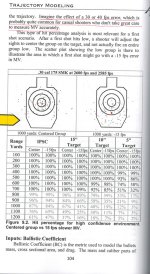Brian,
1)Getting the number at any two ranges works. Actual "muzzle" velocity is still irrelevant. You'd be much better off to get the values at 20 yards and 100 yards than at "muzzle" and 15 or 20 feet.
That is EXTREMELY lazy thinking.
Explain to me again how a non-linear drag function is better calculated without an exact muzzle velocity? You can't, especially not for high drag projectiles.
Let me put it to you this way, one data point is just one data point. Two data points will give you a line between them, a "linear approximation" for the continuous state change
between the two points. Three data points will give you an estimate of a curve. More data points means you better describe the curve, and if you have an actual measurement at the origin you can have the higher confidence in your math than if you don't.
Ballisticians use doppler radar to track velocity changes across the entire range of flight for use in calculating BC for a new projectile. You can only extrapolate a line from two points on the curve, so unless you have some magical formulas that defy physics as I know it that can define a curve from a line....
Heck, maybe you do, but then again maybe you are suffering from the Dunning-Kruger Effect here...
2)Let me know when we need that scenario applies.
http://www.defense-technology.com/products.aspx?pid=3027
Tell me again how getting a velocity reading on that bad boy at 100 yards would do you any good? Answer, it won't, max listed effective range is only a fifth of that distance.
Or if you want something from a rifle:
http://always-on-target.com/cartridges/short-stop-srta-cartridges/ or
http://www.setcan.com/simunition_ammo.php
Now I get what you are saying, that you don't need an exact muzzle velocity for most ballistics applications, and I do agree with that, for commercial bullets launched within normal velocity ranges. Want to launch a 750gr hard cast .510 7 radius bullet at 650 fps? Actual muzzle velocity might be important...
Jimro


